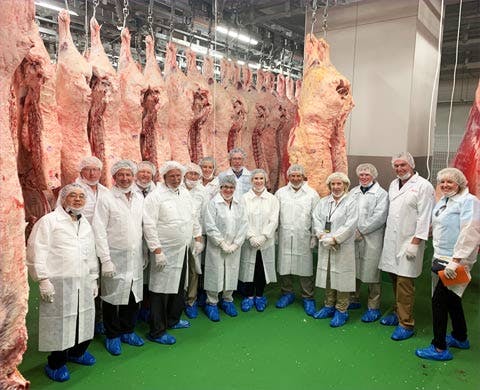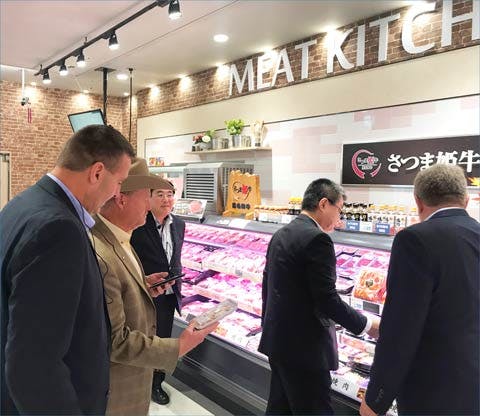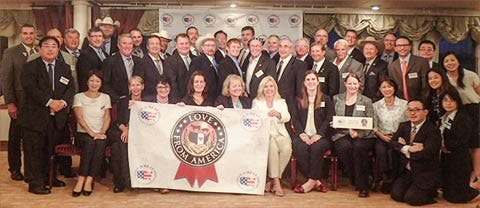USMEF Heartland Team Sees Great Potential for U.S. Beef, Pork Export Growth in Japan
A record 31 producers and agricultural industry leaders traveled to Japan earlier this month as part of USMEF’s Heartland Team, a trade mission designed to introduce beef, pork, soybean and corn farmers to U.S. red meat’s leading export market and allow them to share the story of American agriculture with Japanese importers and consumers.

Tim Chancellor, president of the Nebraska Pork Producers Association, examines a U.S. pork promotional display during a retail tour by the USMEF Heartland Team
“The Heartland Team is an opportunity for USMEF to bring a cross section of our membership to one of our key markets and show them a little bit of everything that we are doing to develop and increase demand,” said USMEF President and CEO Dan Halstrom. “Team members were able to get a feel for the culture and all of the moving parts that go into working in the leading international destination for U.S. red meat. At the same time, the producers put a face on U.S. agriculture – and that goes a long way with our customer base, especially in a country like Japan. The trip is set up to provide many interactions between producers and customers, which is invaluable. We build demand for U.S. red meat through relationships, and I think the Heartland Team members better understand that now.”

A visit to Tokyo Meat Market allowed members of the Heartland Team to see how beef and pork products are stored, broken down and packaged for Japanese consumers
Included in the trip were meetings with key players in the Japanese food trade, tours of retail outlets and restaurants, as well as a look at Japanese domestic meat production. Team members answered consumers' questions and spoke directly about the quality and safety of U.S. red meat. Meetings and events during the week enhanced the image of U.S. production, said Halstrom, who summarized the mission by saying, “A very important customer got to know us a little better.”

(left to right) Dean Meyer and Cevin Jones join USMEF-Japan staff at a retail meat case as the Heartland Team learns how Japanese retailers present U.S. red meat and how U.S. competitors package and market their products
Bringing the Heartland Team to Japan was also an opportunity for producers to witness how USMEF works in export markets. The team received market briefings from the USDA Foreign Agricultural Service (FAS) and the Agricultural Trade Office (ATO), met with U.S. packer representatives, the Japan Meat Trader Association and several Japanese meat buyers. The group also toured large retail outlets, witnessed U.S. meat promotions and participated in consumer events. This included an “Urban Barbecue” event, which highlighted the premium flavor of U.S. red meat for Japanese consumers and showed how American culture and cooking styles are gaining traction as popular food concepts in Japan.
USMEF has worked to develop and promote the growing American barbecue trend, which modifies traditional Japanese cooking methods. The Heartland Team dedicated some of its time in Japan to demonstrating barbecue techniques.
“Barbecue and grilling, we found out, is a pretty foreign concept in Japan, so we gathered a big group and grilled some back ribs and some ribeye steaks,” said David Preisler, CEO of the Minnesota Pork Producers Association. “It was interesting because it’s something many Japanese consumers are not used to doing and we had some good conversations. We coached them on how to do it themselves instead of us doing it for them. There were bloggers and Instagrammers sharing their stories about U.S. beef and pork barbecue, which helped spread the word.”
Dan Hanrahan, a beef producer from Cumming, Iowa, said the great thing about the Urban Barbecue event was being able to connect directly with Japanese consumers.
“I had my phone out, showing them pictures of my farm and videos of my cow herd at various stages – young calves and cows going through the chute – so it was very nice to have that interaction,” said Hanrahan. “As we were standing there, I could see them actively sharing the information on social media. So, what we did, sharing our stories, will have a ripple effect that will continue into the future.”
Retail visits also enabled team members to meet with Japanese consumers and learn about tastes and preferences. These interactions confirmed that brand-conscious Japanese consumers seek out high-quality, safe products that are often backed by a story.
“When we went to supermarkets and saw how well U.S. beef and pork was represented, it made me feel good about our investment in USMEF and the work that is being done in Japan,” said Caleb Plyer, a beef producer from Hope, Arkansas, and chairman of the Arkansas Beef Council. “It's really amazing the job the USMEF staff is doing in Japan. The connections they have with the buyers and packers is impressive. We got to see many examples of what they're doing to improve demand for U.S. red meat. It’s big things and it’s little things, like identifying items and cuts that fit the palates of the Japanese consumers, because they don't eat the same things we do.”

Mark Scott, a corn producer from Wentzville, Missouri, and president of the Missouri Corn Growers Association, participates in a grilling demonstration for a group of food bloggers on the Heartland Team’s recent visit to Japan
Clark Price, a beef producer from Hensler, North Dakota, noted the reaction of Japanese consumers to the USMEF promotional displays.
“USMEF had samples of some U.S. beef and people would walk up and get a sample – then that person would go back to the meat counter and purchase U.S. beef, so that activity was driving buying decisions right there in front of us.” said Price, past chairman of the North Dakota Beef Commission and co-chair of the Beef Checkoff Program's Export Growth Committee. “So, for me, I think USMEF's approach to getting U.S. red meat in front of the consumers really influences consumers’ buying decisions. And I’m happy that organizations like the North Dakota Beef Commission are investing in those efforts.”

Heartland Team members pose for a group photo during the team’s recent visit to Japan
The Heartland Team learned that, along with educating consumers about the quality of U.S. beef and pork, USMEF also focuses on the businesses that prepare and sell food in Japan.
“They bring in people who actually purchase the meat for restaurants or hotels or grocery stores and have them sample what can be done with our meat, how you can make these really flavorful dishes with the products we sell them,” said Mike Korth, a soybean producer from Randolph, Nebraska, and a director of the United Soybean Board.
Cevin Jones, USMEF chair-elect and a beef producer from Eden, Idaho, said the experience confirmed what he has heard about Japanese consumers' fondness for U.S. red meat.
“My impression of the Japanese market is that they are very loyal, and many are loyal to U.S. beef and pork – and now that it has access in Japan, we can start promoting U.S. lamb,” said Jones. “They see our products as superior in both quality and reliability. It’s also important that we remember that U.S. red meat is providing a value to them and we want to keep working hard to maintain that image.”

The Heartland Team toured a processing plant in Sendai, Japan, where U.S. beef tongue is immensely popular with consumers
The team also traveled to Sendai to tour a Wagyu farm, a beef tongue processing plant and to observe the popularity of beef tongue at a local restaurant. Team members – even those who aren’t beef producers – gained a much greater understanding and appreciation for how this item impacts the bottom line for U.S. beef producers.
“Japanese consumers prefer thinly sliced meats and beef tongue is a much-desired product,” says Dean Meyer, a livestock and grain producer and USMEF Executive Committee member from Rock Rapids, Iowa. “The demand for beef tongue in Japan is a great example of how important and valuable this market is for us. The Japanese diet creates demand for cuts and variety meat products that have little demand in the U.S.”
John Hinners, USMEF vice president for Industry Relations, said U.S. pork products are also popular in Sendai – typically pork butts and hams that are shaved or thinly sliced for hot pot and other Asian dishes.
“It was really exciting for members of the Heartland Team to see both U.S. beef and pork products that they raise being brought in and prepared before they get to the Japanese consumers,” said Hinners.
On the trade front, the mission took place on the heels of an agreement in principle that would bring Japanese tariffs on U.S. beef, pork and other agricultural products in line with tariffs of our competitors.
Already the leading value market for U.S. beef and pork, Japan holds even more potential if the U.S. can get back on a level playing field, Halstrom noted. All of U.S. pork and beef’s major competitors gained tariff relief in Japan this year through the Comprehensive and Progressive Agreement for Trans-Pacific Partnership (CPTPP) and the economic partnership agreement between Japan and the European Union.
For example, the duty rate on U.S. beef tongues is 12.8%. If the U.S. is put on a level playing field with the CPTPP countries, the rate is reduced by more than half – down to 5.7% – and phases to zero by 2028. U.S. beef muscle cuts are subject to a 38.5% tariff, while the CPTPP rate is 26.6% and will gradually decline to 9%.
“There is tremendous potential in this market and great enthusiasm about the prospect of an agreement,” said Jones. “In our meetings with the Japanese trade, we were talking with Japanese importers about how we can regain and expand U.S. market share.”
Another key takeaway from the Heartland Team trip was the noticeable camaraderie between U.S. agricultural producers.
“I'm a corn farmer, not a livestock guy, but we're all trying to do the same thing,” noted Jay Fischer, a corn and soybean producer from Jefferson City, Missouri, and vice chairman of the Missouri Corn Growers Association. “We are all trying to market our product in other countries like Japan. On this mission, getting to meet farmers and ranchers from other states was enlightening. Agriculture's pretty different from one part of the United States to the other. Yet we have one goal, to feed the world, and we have a special bond because of that.”
